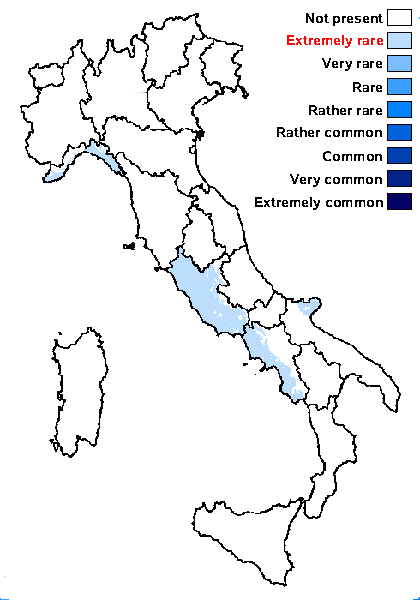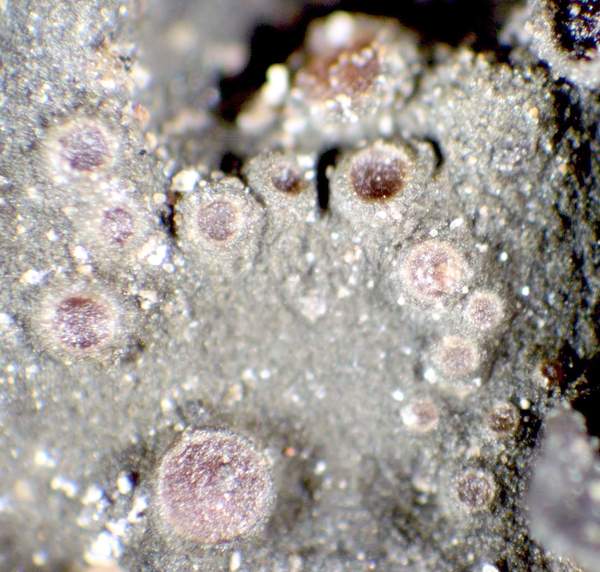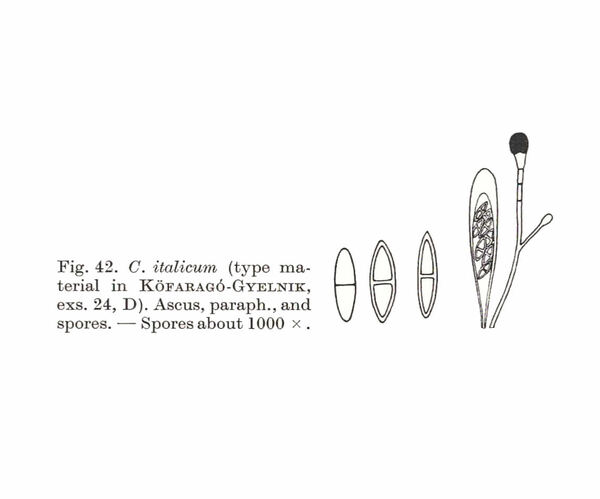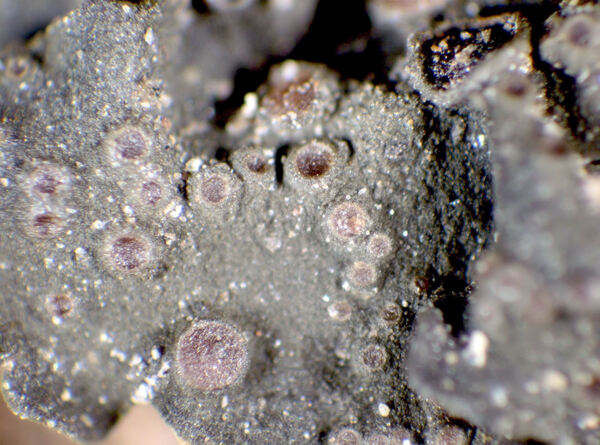Paracollema italicum (B. de Lesd.) Otálora, P.M. Jørg. & Wedin
in Wedin & al., Studies in Fungi, 2, 1: 209, 2017. Basionym: Collema italicum B. de Lesd. - Bull. Soc. Bot. France, 84: 282, 1937.
Synonyms:
Distribution: N - Lig (Ravera & Giordani 2007, 2008). C - Laz (Ravera 2001, Massari & Ravera 2002, Ravera & Giordani 2007, 2008). S - Camp (Ravera & al. 2020), Pugl (Brackel 2011).
Description: Thallus small-foliose, homoiomerous, gelatinous when wet, dark olive green to greenish brown, paler green and semi-transparent when wet, loosely attached, forming up to 1(-1.3) cm wide rosettes. Lobes concave (when young) to flat, smooth to slightly wrinkled, 1-3.5 mm wide, 70-100(-120) μm thick when wet, rounded at apices, usually not isidiate, rarely with initially globose but finally flattened isidia; lower surface paler, with scattered white hapters. Upper and lower cortex absent. Apothecia lecanorine, sessile, usually crowded, (0.2-)0.3-0.5(-0.7) mm across, with a glossy brown, flat to convex disc, and a smooth thalline margin. Thalline exciple ecorticate; proper exciple thin, euthyplectenchymatous; epithecium dark brown; hymenium colourless, 45-70 μm high, K/I+ blue; paraphyses branched, 1.5-2 μm thick at mid-level, the apical cells clearly swollen, the terminal one subglobose, 4-8 μm wide; hypothecium colourless to brownish yellow. Asci 8-spored, very small (30-45 x 8-9 μm), narrowly clavate to subcylindrical, with a distinct, amyloid, tube-like apical structure. Ascospores 1-septate, not constricted at septa, hyaline, narrowly ellipsoid to fusiform, 9-13(-15) x 3-4(-5) μm. Pycnidia frequent, mostly marginal, paler than thallus. Conidia bacilliform, thicker at both ends, 3-3.5 x c. 1 μm. Photobiont cyanobacterial (Nostoc, the cells in long chains). Spot tests: all negative. Chemistry: without lichen substances. Note: a mild-temperate, Mediterranean-Atlantic species restricted to a few humid sites in Tyrrhenian Italy and the Gargano Peninsula, on trees such as Olea and Quercus ilex. It is included in the Italian red list of epiphytic lichens as “Endangered” (Nascimbene & al. 2013c).
Growth form: Foliose, narrow lobed
Substrata: bark
Photobiont: cyanobacteria, filamentous (e.g. Nostoc, Scytonema)
Reproductive strategy: mainly sexual
Most common in areas with a humid-warm climate (e.g. most of Tyrrenian Italy)
Commonnes-rarity: (info)
Alpine belt: absent
Subalpine belt: absent
Oromediterranean belt: absent
Montane belt: absent
Submediterranean belt: absent
Padanian area: absent
Humid submediterranean belt: extremely rare
Humid mediterranean belt: extremely rare
Dry mediterranean belt: absent

Predictive model
Herbarium samples
Growth form: Foliose, narrow lobed
Substrata: bark
Photobiont: cyanobacteria, filamentous (e.g. Nostoc, Scytonema)
Reproductive strategy: mainly sexual
Most common in areas with a humid-warm climate (e.g. most of Tyrrenian Italy)
Commonnes-rarity: (info)
Alpine belt: absent
Subalpine belt: absent
Oromediterranean belt: absent
Montane belt: absent
Submediterranean belt: absent
Padanian area: absent
Humid submediterranean belt: extremely rare
Humid mediterranean belt: extremely rare
Dry mediterranean belt: absent

Predictive model
| Herbarium samples |
 INDEX FUNGORUM
INDEX FUNGORUM
 GBIF
GBIF






